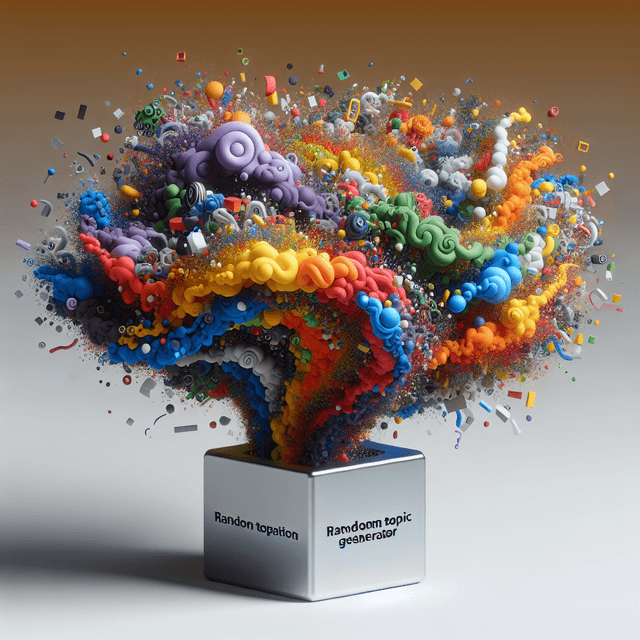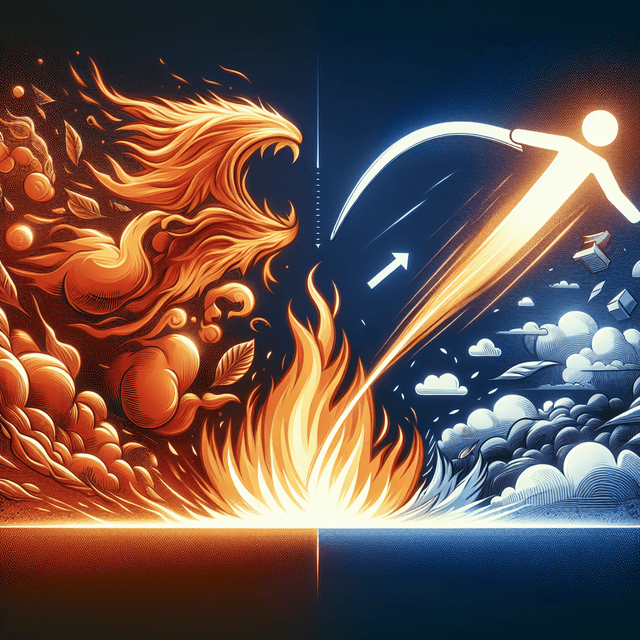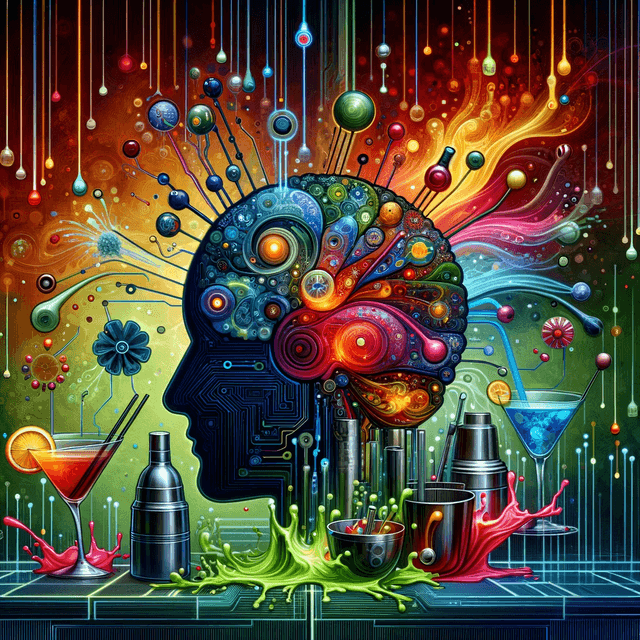
Metaphor Maker
Transform your ideas into vivid metaphors that captivate your audience and enhance your writing.
Instructions
- Type in a concept or idea you want to explore metaphorically.
- Press Generate and Typli will craft a unique and imaginative metaphor for you.
Try more AI writing tools
There's 112 to choose from.

Ship Name Generator
Create the perfect ship name for your favorite couples or characters. Get creative and unique name ideas instantly.

Emoji Inserter
Add 🎉 personality to your messages with the Emoji Inserter. Find the perfect 💬 emoji to express your 😊 emotions and enhance your 📲 communication.

Metaphor Maker
Transform your ideas into vivid metaphors that captivate your audience and enhance your writing.

AI Love Letter Generator
Express your deepest emotions with the help of our AI love letter generator.

Random Topic Generator
Generate endless inspiration with a random topic generator for all your creative projects.

Roast Comeback Generator
Unleash your inner comedian with tips on formulating the perfect roasts and comebacks. From timing to tone, master the art of quick wit effortlessly!

Poem Generator
Transform your words into powerful poetry with our AI poem generator. Express yourself in new and creative ways.

Song Lyric Generator
Embrace the future of music creation with our AI Song Lyric Generator, blurring the lines between human and machine creativity.

Rap Generator
Discover how AI-generated lyrics can enhance your songs and inspire new creative directions for your music.

Birthday Wish Generator
Inspire and uplift with age-appropriate birthday messages - Make your wishes impactful and heartfelt

Band Name Generator
Unleash your inner rockstar with our band name generator and find the perfect name for your band.

Drink Name Generator
Create catchy and exciting drink names with our AI-powered drink name generator.

Song Name Generator
Make your music stand out with a one-of-a-kind title generated by our AI song name generator.

Team Name Generator
Find the best team name for your sports team, club, or organization with our team name generator.

Baby Name Generator
Discover the perfect AI-generated baby name with our innovative AI baby name generator.
Mastering the Art of Metaphors
Metaphors have the unparalleled power to transform simple messages into rich, vivid imagery that captivates the imagination. At its core, a metaphor is a figure of speech where a word or phrase is applied to an object or action to which it is not literally applicable. This might sound fancy, but it's something we encounter daily. Metaphors enrich our language, making the mundane magnificent and the plain picturesque. They are not just tools for poets or novelists but are essential for anyone looking to enhance their communication, whether in writing, speech, or even visual art.
The importance of metaphors extends beyond mere decoration. They enable us to express complex ideas and emotions in a way that's accessible and relatable, bridging the gap between the abstract and the concrete. With a well-crafted metaphor, you can convey more depth and insight than you could with literal language alone. Thus, understanding and skillfully crafting metaphors is not just an academic exercise but a practical skill with real-world applications, from literature and art to daily conversations and persuasive speaking.
In this guide, we'll explore what makes metaphors such a powerful tool, delve into their history, types, and how they function, and offer practical advice on creating and using metaphors effectively. Whether you're a writer seeking to enrich your narrative or a speaker aiming to captivate your audience, mastering the art of metaphors can open up new dimensions in your communication and creative expression.
Key Takeaways
-
Metaphors are powerful linguistic tools that create implicit comparisons between unrelated things, enriching communication and thought.
-
Unlike similes and analogies, metaphors imply similarity without using "like" or "as," and are more about conceptual connections than direct comparisons.
-
The use of metaphors dates back to ancient civilizations and has evolved to become a fundamental element in literature, rhetoric, and everyday language.
-
There are various types of metaphors, including standard metaphors, extended metaphors, implied metaphors, and visual metaphors, each serving different purposes.
-
Creating effective metaphors involves understanding their anatomy, generating ideas by drawing connections between disparate concepts, and carefully crafting the comparison.
-
The natural world, personal experiences, and abstract concepts can serve as rich sources of inspiration for metaphor creation.
-
Mastering the art of metaphors enhances not only writing and speech but also fosters a deeper understanding of the world and our place in it through the lens of imaginative comparison.
Understanding Metaphors
At the foundation of mastering metaphorical language lies the need to understand what a metaphor is and how it differs from other figures of speech. A metaphor creates an implicit comparison between two unrelated things, suggesting a similarity between them without using "like" or "as," which are hallmarks of similes. For example, saying "life is a journey" compares life to a journey, emphasizing the idea of progress, adventure, and challenges without stating outright that they are the same.
Distinguishing metaphors from similes and analogies is crucial. While similes also compare two different entities, they do so explicitly using "like" or "as." An analogy, on the other hand, draws a comparison between two things to explain something unfamiliar in terms of something familiar, often in a more extended, logical manner than metaphors.
The cognitive function of metaphors is profound. They're not just a linguistic ornamentation but a way of thinking and perceiving the world. Metaphors help our brains understand new or abstract concepts by relating them to familiar experiences. This is why metaphorical language is not only pervasive in our everyday language but also a powerful tool in science, education, and politics, helping convey complex ideas in a relatable way.
The History of Metaphors
The use of metaphors is as ancient as language itself, evolving alongside human civilization. The roots of metaphorical language can be traced back to the earliest forms of oral and written traditions. Aristotle, in his work "Poetics," was among the first to formally study and document the use of metaphor as a rhetorical device, setting the foundation for centuries of literary analysis.
Throughout history, metaphors have been a vital component of great speeches, literary masterpieces, and philosophical texts. They have the power to capture the essence of an era, reflect societal values, or challenge prevailing ideologies. Shakespeare, for instance, is renowned for his inventive use of metaphors, which have left a lasting impact on the English language and literature.
The evolution of metaphors parallels the evolution of human thought and language. In literary traditions around the world, metaphors have served as a bridge between the known and the unknown, the seen and the unseen, enabling writers and poets to explore and express complex realities that defy straightforward description.
Types of Metaphors
Metaphors come in various forms, each serving a different purpose and effect. Understanding these types can enhance your ability to both recognize and craft effective metaphors:
-
Standard Metaphors : These are direct comparisons between two unrelated things, stating that one thing is another. For example, "The world is a stage," implies that life is like a play, with each person fulfilling a role.
-
Extended Metaphors : These metaphors continue throughout a paragraph, or even the entire length of a work, building upon an initial metaphor with more detail or varied comparisons. John Donne's "A Valediction: Forbidding Mourning" uses an extended metaphor of a compass to explore themes of love and separation.
-
Implied Metaphors : These are more subtle, not directly stating one thing is another but implying the comparison through descriptive elements. Saying, “The fog of her memory,” suggests the person's memory is clouded or unclear.
-
Visual Metaphors : Common in art and advertising, these metaphors use visual elements to compare or represent something else, like using a lion to represent courage in a poster.
By mixing and matching these types, you can create layered, richly detailed metaphors that captivate and communicate with tremendous effectiveness.
How to Create Powerful Metaphors
Creating striking metaphors requires practice and a deep sense of curiosity about the world around you. Here's a step-by-step guide to crafting your metaphors:
-
Understand the Anatomy of a Metaphor : Recognize the two parts – the tenor (the subject to which attributes are ascribed) and the vehicle (the subject from which the attributes are borrowed).
-
Generate Ideas : Look for connections between seemingly unrelated concepts. Consider personal experiences, draw inspiration from nature, or tap into universal themes.
-
Craft Your Metaphor : Once you have your connection, conceptualize how best to present it. Will it be a direct comparison, or perhaps an extended metaphor to explore the idea in depth?
Tips for Generating Metaphorical Ideas
-
Explore nature : The natural world offers endless inspiration for metaphors. Look at how the seasons change, the lifecycle of a butterfly, or the strength of a river cutting through rock.
-
Use your experiences : Personal stories and emotions can create powerful, relatable metaphors. Reflect on your journeys, struggles, and triumphs.
-
Embrace the abstract : Sometimes, the most compelling metaphors come from abstract thinking. Delve into concepts like time, love, or freedom, and consider their characteristics or effects.
Creating metaphors is an exploratory process, a dialogue between your imagination and reality. It's about finding those magical connections that illuminate ideas in a new light.